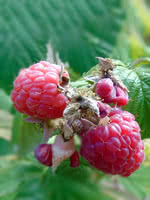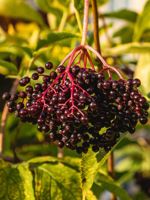Mon-Fri 9am - 5pm Mountain time
Wild Red Raspberry vs Bob Gordon Elderberry
Rubus idaeus
Sambucus canadensis Bob Gordon
The Wild Red Raspberry produces small, tart, red berries. They are delicious when eaten fresh, but also add flavor to preserves or desserts. They are highly suckering and can be high yielding.
The Wild Red Raspberry is also otherwise known as the American Red Raspberry, European Red Raspberry, Grayleaf Raspberry, or the Common Red Raspberry.
The Wild Red Raspberry are floricanes, primarily fruiting on second year canes. Each spring cut back all two-year old canes, leaving only the last year’s growth. This is a self-pollinating variety, so it doesn’t require a second plant nearby to set fruit.
Bob Gordon Elderberry is a Black Elderberry cultivar that produces berries that are larger and sweeter than other varieties, making it one of the top cultivars. It produces large clusters of white flowers that turn into large clusters of dark purple to black berries. The berries are well-suited for baked goods, jams, jellies, and syrups. It was selected from the wild in Missouri.
The large berry clusters that the Bob Gordon Elderberry produces will often end up hanging downward. This makes it more difficult for birds to feed on the berries. If birds are a concern, this might be the right berry for you.
Black Elderberries are considered to be partially self-pollinating. So while they will still produce some berries without cross-pollination, planting with another variety will increase yields. Consider planting with Black Elderberry or Ranch Elderberry.
Warning: the seeds, stems, leaves, roots, and uncooked berries are toxic to humans when eaten in quantity. Berries should be cooked to make them safe for human consumption.
Wild Red Raspberry Quick Facts
Bob Gordon Elderberry Quick Facts
Toxicity: leaves, stems, and uncooked berries are poisonous to humans

